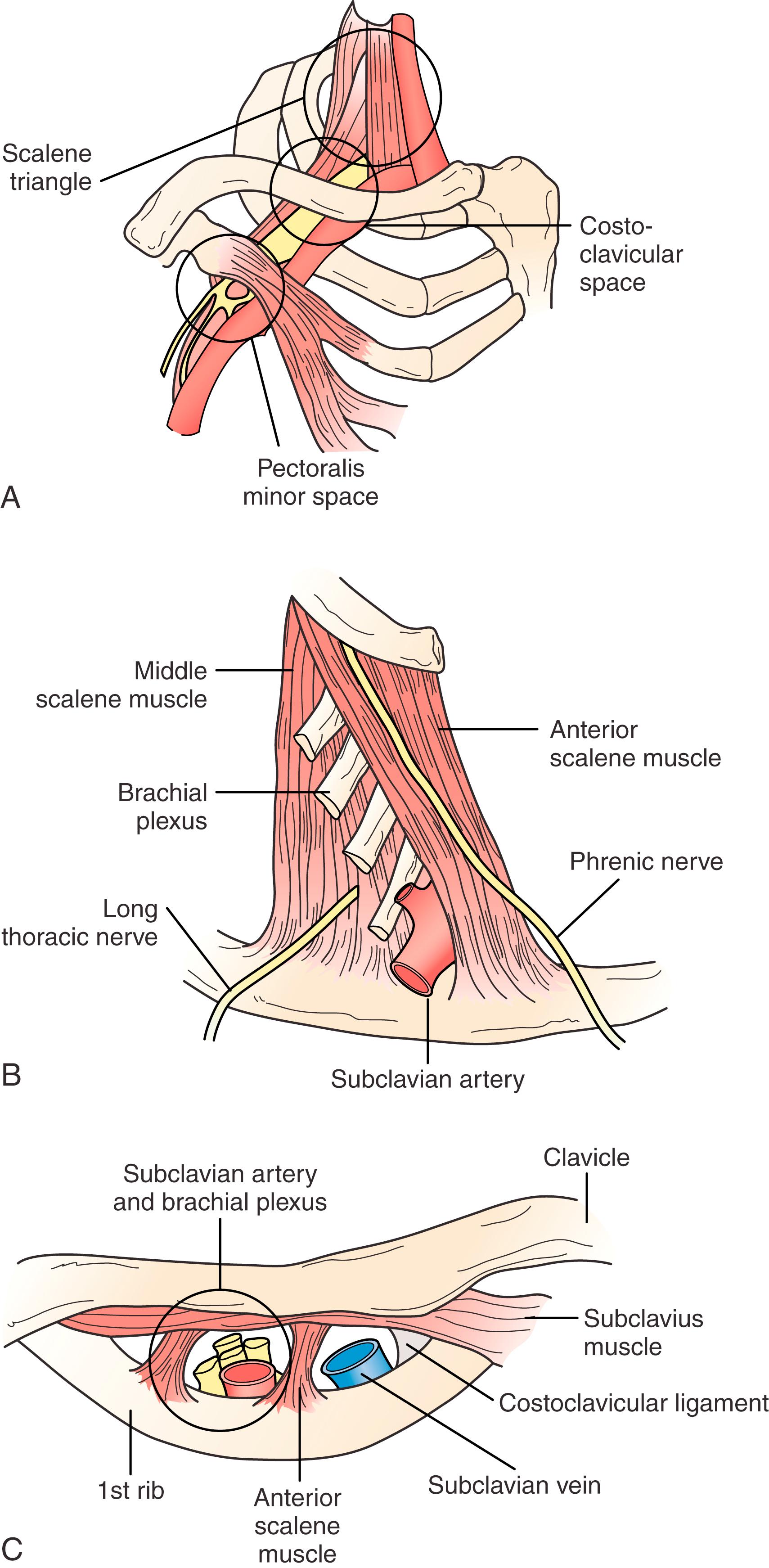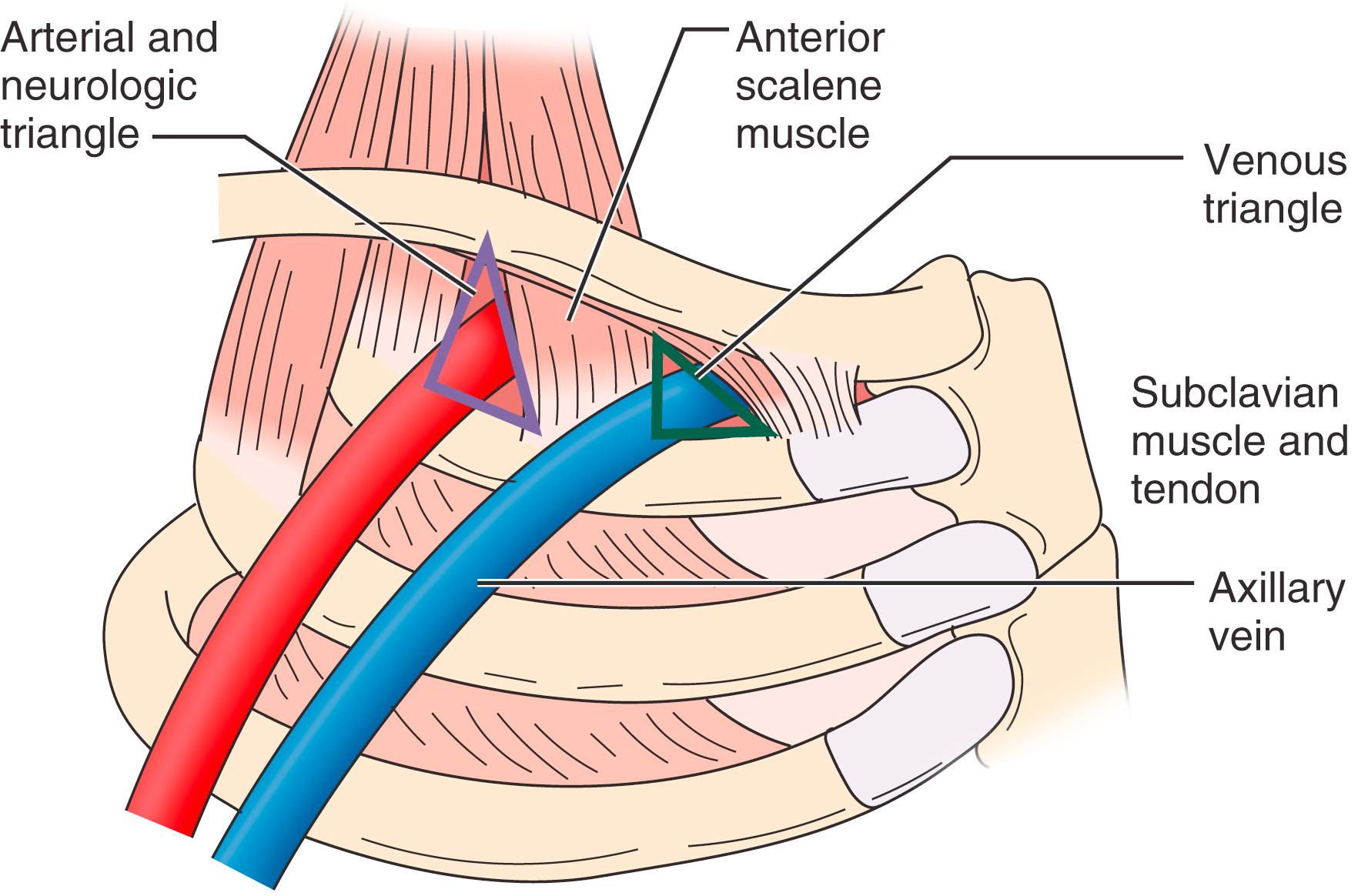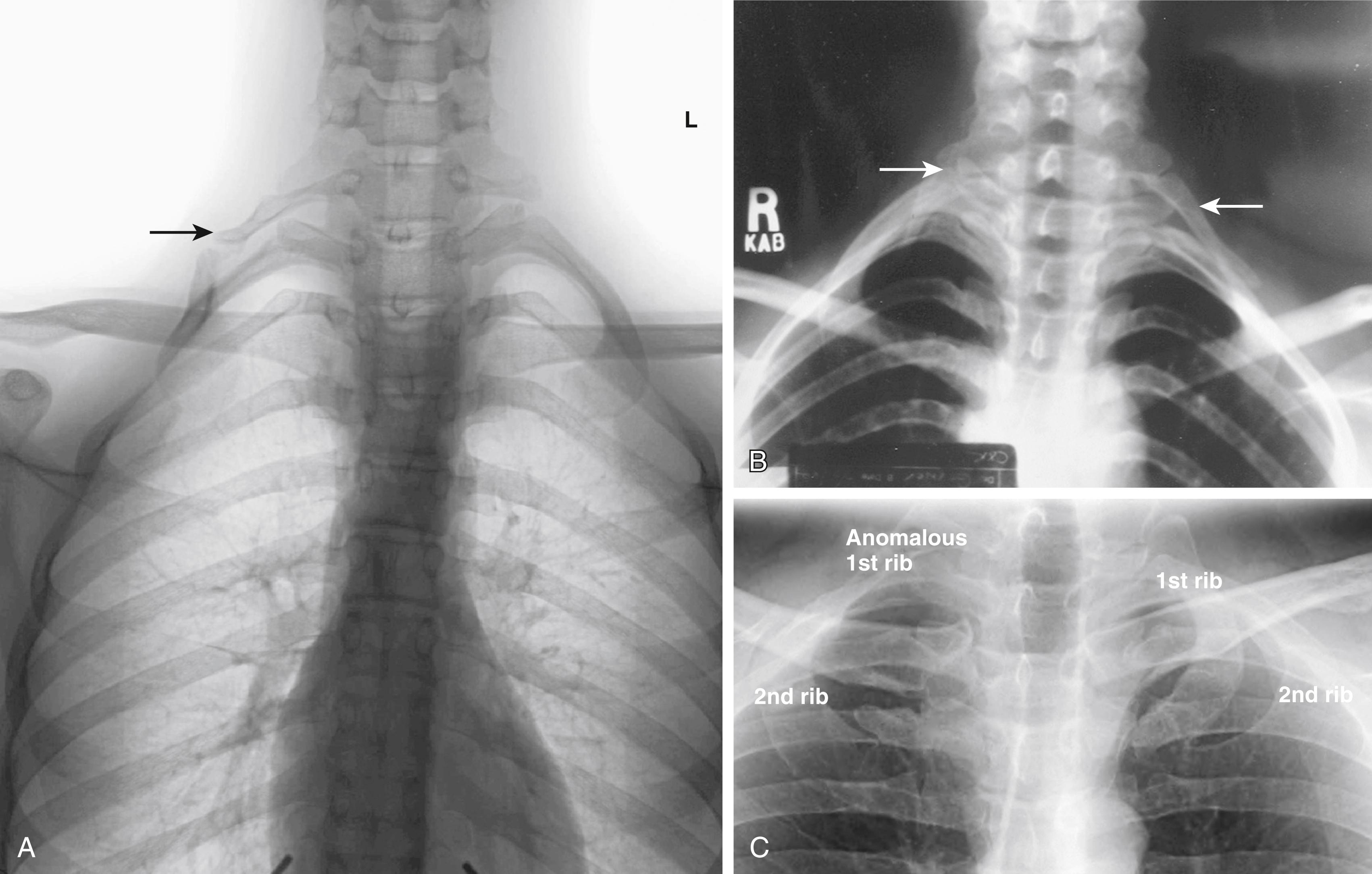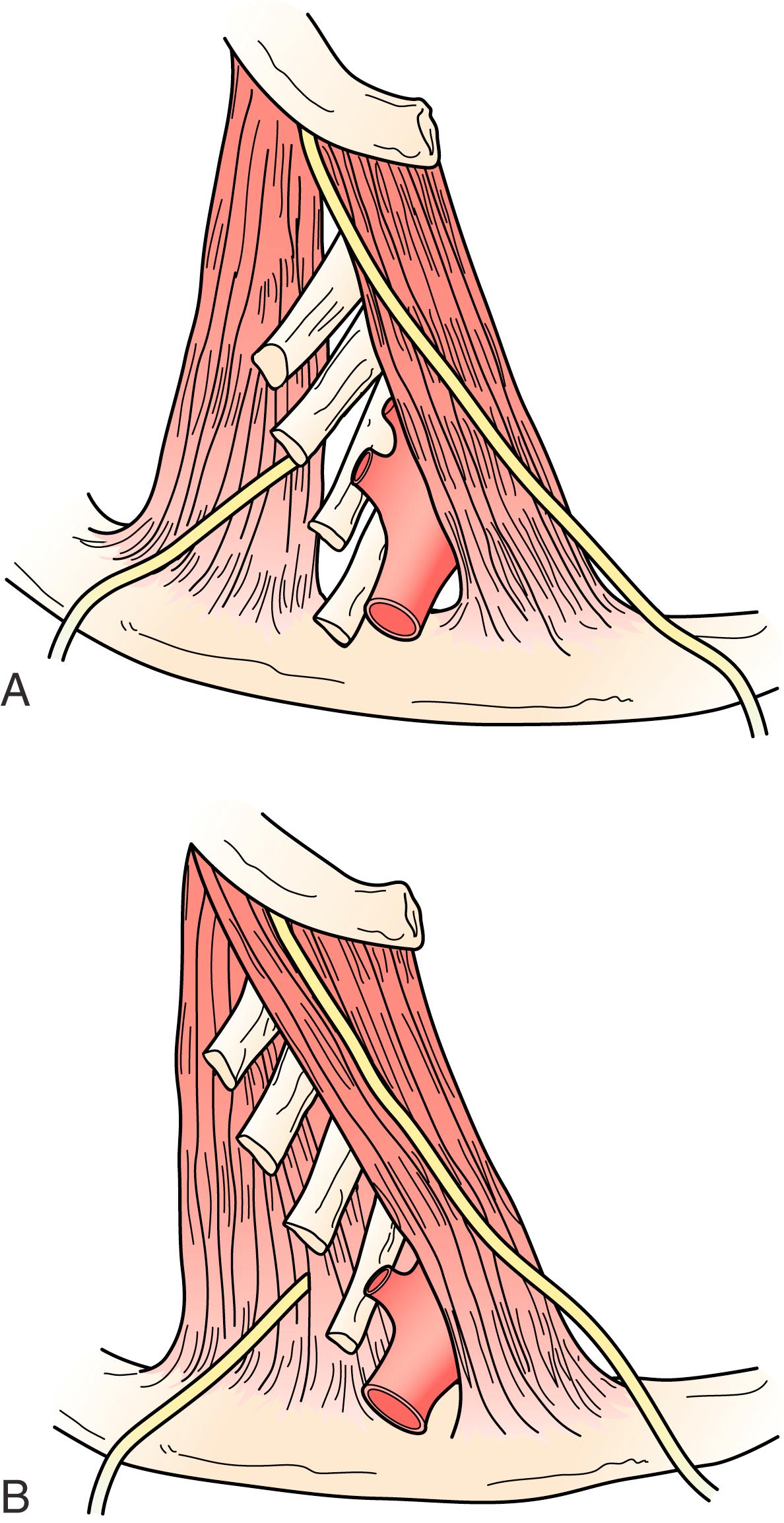Physical Address
304 North Cardinal St.
Dorchester Center, MA 02124
Thoracic outlet syndrome (TOS) is a condition resulting from compression of the neurovascular structures traversing the thoracic outlet. The syndrome is divided into three types based on the symptoms and signs of neurovascular compression. Neurogenic TOS (nTOS) results from brachial plexus compression (see Ch. 124 , Thoracic Outlet Syndrome: Neurogenic), venous TOS (vTOS) results from subclavian vein compression (see Ch. 126 , Thoracic Outlet Syndrome: Venous), and arterial TOS (aTOS) results from subclavian artery compression (see Ch. 125 , Thoracic Outlet Syndrome: Arterial). The distinct symptoms and signs of each of these syndromes are described in Table 123.1 .
| Neurogenic | Venous | Arterial | |
|---|---|---|---|
| Incidence | 95%+ | 3% | 1% |
| Etiology | Neck trauma (i.e., auto accident with whiplash), RSI at work, falls on the floor or ice | Repetitive overhead shoulder movements and/or coagulopathy | Cervical rib or anomalous first rib; rarely, congenital band |
| Predisposing factors | Cervical rib, congenital band, scalene triangle muscle variations | Congenital narrowing of the costoclavicular space by the costoclavicular ligament or the subclavian tendon compressing the subclavian vein | Cervical rib or anomalous first rib eliminating space under the artery |
| Pathology | Scalene muscle fibrosis; occasionally anomalous first rib or cervical rib | Subclavian vein stenosis with or without thrombosis | Subclavian artery stenosis, thrombosis or aneurysm formation with mural thrombus and emboli |
| Symptoms | Extremity pain, paresthesia, weakness plus neck pain and occipital headache, Raynaud phenomenon, chest pain for pectoralis minor syndrome | Swelling of the whole arm, cyanosis, pain | Pain, paresthesia, pallor, coldness; digital ischemia; arm claudication; seldom are there neck or shoulder symptoms |
| Physical examination | Positive response to provocative maneuvers; tenderness over the scalenes, pectoralis minor | Arm swelling, cyanosis, pain | Those with arterial occlusion: decreased pulses at rest, perhaps color changes and ischemic fingertips, distal emboli |
| Diagnostic tests | Duplex scan, scalene muscle block, MRI to rule out other conditions, pectoralis minor block, EMG/NCV, MAC measurement | Duplex scan, venogram | Neck radiograph, duplex scan, arteriogram, digital pressures and waveforms, arteriography |
Most patients with TOS are 20 to 50 years of age. Fewer than 5% are teenagers, whereas 10% are older than 50 years. Seldom is any form of TOS seen in patients older than 65 and 70% are female. There is no explanation for the female predominance, but perhaps it is related to the observation that 70% of cervical ribs also occur in females. The exception to this is the subset of patients diagnosed with vTOS, as there is a 2:1 male predominance in this condition.
TOS is uncommon, but its true incidence is unknown because many people with upper extremity pain and paresthesias could have escaped diagnosis by healthcare providers who may have failed to recognize the diagnosis. Of the TOS subtypes, nTOS is by far the most common form, accounting for more than 95% of all TOS patients; vTOS occurs in 2% to 3%; whereas aTOS comprises fewer than 1% of patients.
These syndromes result from a combination of developmental and anatomic anomalies in the thoracic outlet combined with physical activities and life events that predispose individuals to become symptomatic. A common initiating event is neck trauma, which causes symptoms in patients who may be anatomically predisposed to the development of compression in the thoracic outlet. In this chapter we describe the relevant anatomy, elaborate on the pathophysiology of each type of TOS, and follow up with a discussion of the diagnostic evaluation of TOS.
There are three anatomic spaces that pertain to the thoracic outlet – the scalene triangle, the costoclavicular space, and the pectoralis minor (PM) space ( Fig. 123.1 ). The costoclavicular space is traversed by the subclavian vein and is the most common site of subclavian vein compression ( Figs. 123.1 and 123.2 ). The subclavian artery and brachial plexus traverse the thoracic outlet between the anterior and middle scalene muscles, also referred to as the scalene triangle (see Figs. 123.1 and 123.2 ). The scalene triangle is the most common site of brachial plexus compression. When present, cervical ribs and anomalous first ribs also compress the plexus in this location ( Fig. 123.3 ).



In addition to the brachial plexus, the phrenic and long thoracic nerves are seen during supraclavicular dissections. Very close to the area but rarely seen are the dorsal scapular nerve and cervical sympathetic chain.
The brachial plexus arises from nerve roots C5 to T1. In the scalene triangle area the five nerve roots become three trunks. The anterior and posterior divisions and cords of the plexus are usually formed proximal to the PM space, so it is the branches of the plexus that lie under the PM muscle, along with the axillary artery and vein.
Arising primarily from C4, the phrenic nerve usually receives branches from C3 and C5. It is single in 87% and double or triple in 13% of individuals. The phrenic nerve descends 84% of the time from the lateral to the medial side of the anterior scalene muscle. In the other 16% of individuals, the phrenic nerve remains on the lateral side.
The long thoracic nerve arises primarily from C6 and usually receives contributions from C5 and C7. The C5 and C6 branches run through the muscle belly of the middle scalene muscle, where they usually join. The C7 branch arises from the posterior aspect of the nerve root and often descends below the middle scalene before joining the other two branches.
The dorsal scapular nerve, the first branch of C5, courses through the cephalic portion of the middle scalene muscle and then descends lateral to the muscle. However, it may course very close to the area of dissection in supraclavicular approaches to thoracic outlet decompression.
Though not usually in the operative field of supraclavicular procedures, the cervical sympathetic chain lies over the transverse processes of the cervical vertebrae and is therefore very close to the origin of the anterior and middle scalene muscles. As a result, when cautery is used to excise the scalene muscles at their transverse process origins, the current may reach and damage the cervical sympathetic chain. This is the probable explanation for the occasional case of Horner syndrome observed after supraclavicular scalenectomy.
A significant number of anatomic variations in scalene muscles have been observed both in the normal population and in patients with nTOS. They are too common to be called anomalies. These variations might be regarded as anatomic and developmental variations predisposing to TOS, but are not regarded as causes.
Splitting of the anterior scalene around C5 and C6. Such splitting was noted in 45% of cadavers and in only 21% of nTOS patients.
Scalene minimus muscle. This muscle arises from the transverse processes of the lower cervical vertebrae, runs in front of C8 and T1 and behind the subclavian artery, and inserts on the first rib or Sibson fascia. Its incidence is 25% to 55%.
Interdigitating muscle fibers. Such fibers commonly run between the anterior and middle scalene muscles. They were noted in 75% of nTOS patients and in only 40% of cadavers.
Scalene triangle width. The width of the scalene triangle varies from very narrow to quite wide, with the distance between the two scalene muscles at their insertion on the first rib ranging from 0.3 to 2.0 cm. The nerve roots emerge lower in a wide triangle compared with their pathway in a narrow triangle ( Fig. 123.4 ). Observations during surgery have revealed that most nTOS patients have the narrower type of triangle.

Congenital bands and ligaments. These structures are frequently observed in the normal population, with an incidence as high as 63%. Although bands have been observed in almost every area of the scalene triangle and have been nicely classified, their role is as a predisposing factor rather than a direct cause.
Relationship of the subclavian vein to the phrenic nerve. The phrenic nerve usually runs posterior to the subclavian vein. However, in 5% to 7% of individuals, the phrenic nerve runs anterior to the vein and in this position can be a rare cause of subclavian vein obstruction.
Relationship of the subclavian vein and costoclavicular ligament. The subclavian vein passes cephalad to the first rib just before it is joined by the jugular vein. It is bounded medially by the costoclavicular ligament and superiorly by the subclavius tendon. A variation in the position of the vein is its position more medially on the first rib so that it is partially compressed by the costoclavicular ligament. Variations in the thickness of the subclavius tendon can also result in compression of the vein from above. These variations in position between the three structures predispose to the development of subclavian vein obstruction. Obstruction is then caused by excessive abduction of the upper extremity, which results in compression of the vein against the dynamic outlet created by the costoclavicular ligament, subclavius tendon, and the first rib.
As many as 29% of patients with TOS have been reported to have skeletal anomalies, including cervical ribs, clavicular anomalies, and isolated first rib abnormalities; the majority of which are congenital. Anomalous or rudimentary first ribs are often overlooked on routine chest radiographs. In one study conducted in 1939, 5000 chest radiographs were reviewed. It was found that the incidence of anomalous first ribs and cervical ribs in these subjects was 0.76% and 0.74%, respectively. Anomalous ribs occurred equally in women and men. In contrast, the female–male ratio of cervical ribs was found to be 7:3. Cervical ribs and anomalous first ribs are both narrower and are positioned more cephalad than a normal first rib. The only difference between the two is that a cervical rib arises from the transverse process of C7, whereas an anomalous first rib arises from the transverse process of T1 (see Fig. 123.3 ).
About 30% of cervical ribs are complete ribs fused to the first rib by a true joint or a fibrous attachment. The other 70% are incomplete cervical ribs with no direct attachment to the first rib. However, most of these incomplete ribs have a tight fascial band extending from the tip of the cervical rib to the first rib. The cervical rib and attached band lie within the middle scalene muscle, thereby narrowing the space within the scalene triangle through which the nerve roots of the brachial plexus course. Thus an incomplete cervical rib with associated band can behave like a complete rib. Cervical and anomalous first ribs can compress the subclavian artery and cause stenosis with or without poststenotic aneurysm formation. More commonly, these anomalous ribs compress the lower trunk of the brachial plexus and cause neuropathy. However, most cervical and anomalous first ribs remain asymptomatic throughout life.
When symptoms do develop, they are usually neurogenic. In a recent review of 47 nTOS operations involving abnormal ribs, 15% were performed in the setting of anomalous first ribs and 85% were performed in the setting of cervical ribs. Spontaneous onset of symptoms occurred in 50% of patients with complete cervical ribs versus only 20% with incomplete ribs. Neck trauma preceded the onset of symptoms in the other 80% with incomplete ribs and in the 50% with complete ribs. All patients with cervical ribs are predisposed to the development of some form of TOS, most commonly nTOS. Cervical ribs or anomalous first ribs are almost always present in patients with aTOS. On the other hand, symptomatic cervical ribs are more likely to produce symptoms of nTOS than aTOS. Over a 28-year period during which more than 1000 nTOS operations were performed, there were 39 cervical ribs and 7 anomalous first ribs treated in this group of patients, with an incidence of 4%. Among the same group of TOS patients there were only nine with aTOS, five with complete cervical ribs and four with anomalous first ribs, with an incidence of less than 1%.
The PM can also cause compression of the structures of the thoracic outlet, leading to nTOS, vTOS, and aTOS in rare circumstances. Pectoralis minor syndrome (PMS) results when this muscle causes compressive symptoms in the subcoracoid or PM space. The PM space is actually outside the thoracic outlet area, but compression of the upper extremity neurovascular bundle can occur in this space between the PM muscle and ribs of the chest wall. Although this might better be termed “axillary compression syndrome,” it is appropriate to consider the PM space as an extension of the thoracic outlet area, because compression here is common and the axillary and the thoracic outlet neurovascular bundles contain the same elements (see Fig. 123.1 ). The PM syndrome results from excessive trauma or exercise of the shoulder girdle caused by hyperabduction. The PM muscle becomes tight and hypertrophied and can compress the brachial plexus, axillary vein, and rarely the axillary artery. PMS is frequently responsible for recurrent nTOS after thoracic outlet decompression, being responsible for up to 75% of cases of recurrent nTOS. It is this PM space that should be evaluated more carefully, particularly in patients with recurrent or persistent symptoms, after initial operation for nTOS.
Become a Clinical Tree membership for Full access and enjoy Unlimited articles
If you are a member. Log in here